About the Grand Court Organ

Built for the 1904 St. Louis World’s Fair, the Wanamaker Organ was designed by renowned organ architect George Ashdown Audsley, author of The Art of Organ-Building. The driving force behind the project was Murray M. Harris, a superb organ builder hailed as “The Father of Organ Building in the American West.” Harris was also a shrewd investor and promoter. Living in California, a land with abundant mineral resources and superb lumber from pristine, old-growth forests, Harris was able to invest the finest in materials in his organs, and he brought a group headed by master craftsman William Boone

Fleming into his group to incorporate the latest developments in electric action into his instruments, with the patents that went with them.
During construction of the organ, costs skyrocketed and certain questionable financial manipulations by Harris came to light, causing the company to be taken over by its chief investor, a Colorado mining mogul named Eben Smith. Harris was ousted and the Murray M. Harris company was rechristened The Los Angeles Art Organ Company. But the organ’s soaring $105,000 price tag,
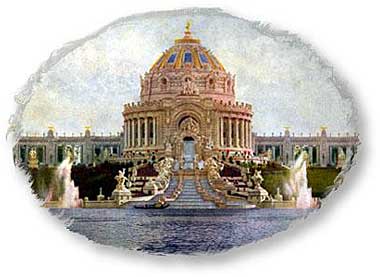
and the refusal, during the Fair, of the Kansas City Convention Hall authorities to accept the organ they had commissioned, would ultimately lead to the company’s demise.
The investment, however, paid huge musical dividends. The heroic instrument that resulted had five manuals, 10,059 pipes, and it won the Grand Prize and five other medals at the Fair, where was played by Alexandre Guilmant and virtually every other notable organist of the day.

In 1909, Philadelphia merchant-prince John Wanamaker bought the instrument for his new Philadelphia emporium. Thirteen freight cars were required to ship the entire organ from St. Louis, and installation took two years. The Grand Organ was first heard in the Store’s seven-story atrium on June 22, 1911, at the exact moment when England’s King George V was crowned at Westminster Abbey. Later that year, it was prominently featured when President William Howard Taft dedicated the Store.
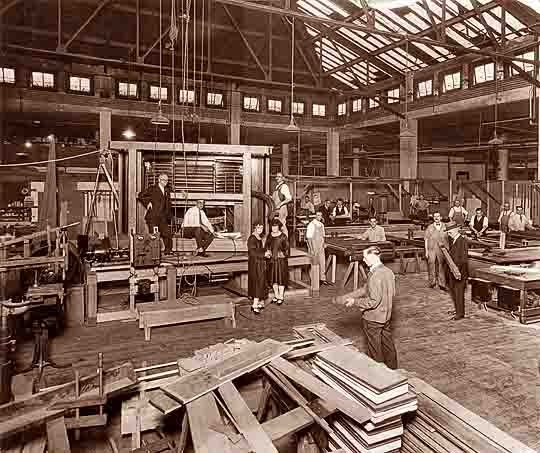
 Despite its immense size, the organ tone was judged inadequate to fill the huge court. Wanamaker’s opened a private pipe-organ factory in the Store attic, employing up to 40 full-time employees to enlarge the instrument. William Boone Fleming, the original factory supervisor, was hired to direct the work.
Despite its immense size, the organ tone was judged inadequate to fill the huge court. Wanamaker’s opened a private pipe-organ factory in the Store attic, employing up to 40 full-time employees to enlarge the instrument. William Boone Fleming, the original factory supervisor, was hired to direct the work.
From the beginning, the instrument was an Art Organ. Lavish construction, expensive materials and elegant workmanship made the Wanamaker Organ both a tonal wonder and a monument to superb craftsmanship. The largest pipe is made of flawless Oregon sugar-pine three inches thick and more than 32 feet long—so large that a Shetland Pony was once posed inside for publicity photos.

Supervising tonal matters was George W. Till, a superb voicer who is credited by many for the Wanamaker Organ’s beautiful tone. It is said that Marcel Dupré used to embrace him whenever he saw him. All wood pipes were made in the Wanamaker Shop. Metal pipes were purchased from supply houses to strict quality specifications and regulated on-site. Among Till’s stop contributions were the Clear Flute, perhaps the most noble and well known flute stop in any organ, and compound stops of two ranks with intriguing sounds such as the Nasard Gambas and the Quint Flute. Till devised the Pedal 10-rank mixture, which Audsley praised for its reed-like tone.
In an unusual move for the times. Audsley had insisted on the necessity of mixtures, and his dictum on this and numerous other ideas were faithfully followed through throughout the instrument’s long development, leading to its overall unity of concept and harmonious inter-blending.

Mr. Till was also an inventive genius and his brilliance with pneumatic and mechanical devices led to advances such as the first piano played by an organ, selective mixtures, adjustable tremolos and expression-shoe couplers. The color coding of stop tablets and couplers was also a Till innovation.
Insisting on quality, Rodman Wanamaker during the 1920s wanted “all the tonal glory of the orchestra” added to the instrument, making it a perfect organ and orchestra built of pipes.
Completing the picture is organist Charles M. Courboin, a Rodman Wanamaker favorite and one of the brilliant virtuosos of his day, who was a driving force behind the String, Orchestral and Great Chorus divisions that capped the completed instrument. Courboin also thought in terms of making choirs out of the same sort of stop, such as Cellos, Dulcianas, French Horns, Flutes Vox Humanas, Orchestral Violins and Muted Violins.
During Courboin’s tenure the Store began buying pipes from leading builders, particularly the W.W. Kimball Company of Chicago, although vendors acted as supply houses and were not permitted to publicly advertise their contributions. In addition, Courboin is also largely credited for the visionary layout of the present six-manual console.
Hear Charles M. Courboin play Wagner’s “To the Evening Star” on the Wanamaker Organ HERE
The smallest pipe is a quarter-inch in length. More than 8,000 pipes were added to the Organ between 1911 and 1917, and from 1924 to 1930 an additional 10,000 pipes were installed, bringing the total number of pipes today to 28,750.

During the lifetimes of John Wanamaker and his son Rodman, the world’s finest musicians were brought to the Store for brilliant after-business-hours concerts, among them France’s Marcel Dupre, Louis Vierne and Nadia Boulanger, Italy’s Fernando Germani and Marco Enrico Bossi, and England’s Alfred Hollins.

At a 1919 Musicians’ Assembly, virtuoso Charles M. Courboin, in association with Leopold Stokowski and the Philadelphia Orchestra, performed before a standing-room-only crowd of 15,000. Since then, great organists have continued to perform at the Store, many making special pilgrimages.

In 1986, the evening-concert tradition was continued as the Grand Organ marked its 75th anniversary with a Keith Chapman recital that attracted a huge audience. More recently, elaborate music events have regularly been sponsored by the Friends of the Wanamaker Organ, attracting visitors to Macy’s with representatives from all parts of the U.S.
In 2008 Macy’s celebrated its 150th anniversary with a Philadelphia Orchestra concert under Maestro Rossen Milanov. At the Wanamaker Organ, Peter Richard Conte performed Joseph Jongen’s Symphonie Concertante (1925) for the first time with the organ and orchestra for which it had been written.
Now a National Historic Landmark and valued in excess of $79 million, the Wanamaker Organ is of the American Symphonic design, which can play the great organ masterworks as well as the entire range of orchestral literature. The pipework encompasses the resources of three symphony orchestras; its String Organ alone has 7,000 pipes.
Organ Tonal Resources

In accord with its overall design as an ideal concert organ, the Wanamaker Organ is a Straight Organ with a minimum of unification. Borrowing of stops is used sparingly, mainly in the Pedal and Orchestral, where it has great value. Duplexing of stops is reserved for the few instances where valuable solo voices can be separated from their divisions without tying up the remainder of tonal resources there. Choruses (16′, 8′ and 4′) are true choruses of three ranks, with each set of pipes expressiong its own personality, rather than a single rank electrically “tapped” at three pitches, with the resulting weakening of any octaves, and sameness of tone between the three voices. Rigorous adherance to traditional organ design is another major factor in the instrument’s abiding success.

THE CHOIR, consisting of sublime, delicate voices, is on five inches of wind pressure, and is one of the many soft sections that mass to form beautiful “carpets” of rich tone that can serve as accompaniment for the bolder voices found elsewhere in the Organ.
THE GREAT DIVISION is on wind pressures of five to sixteen inches, and consists of unenclosed stops as well as a section enclosed with the Choir division. Together the Enclosed Great and Choir can be electrically combined to form a single expressive division independent of the Unenclosed Great.
IN TWO HUGE EXPRESSION CHAMBERS, THE SWELL is on wind pressures of five to twenty-two and one-half inches. All stops are under expression. One of these expression chambers houses the Original String division designed by George Ashdown Audsley—the first independent String organ ever found in a pipe organ.
THE ENTIRE SOLO DIVISION, in the Main Chamber, is under expression, on a wind pressure of fifteen inches. Powerful tubas, bold trumpets, assertive strings and particularly rich diapasons are among the many dominant stops at hand. Milder voices include a beautiful Soft Tuba, a Violin Diapason, a two-rank Nasard Gamba, and a Chimney Flute. Topping the ensemble are seventeen ranks of mixture work. Curiously, the Solo is not heard directly by the player at the console, because of an intervening pillar, but its sound easily bounces off the pillar on the far side of the console, creating for the player the illusion that the sound is coming from the opposite direction. The 51-rank division has recently been enhanced with sound-reflective paneling as it undergoes a complete restoration and pipe cleaning.


THE ETHEREAL ORGAN IS COMMANDING, rich and full in tone, entirely expressive. It has twenty-one stops, and a wind pressure of twenty-five inches. It is located on the seventh floor. An unenclosed E.M. Skinner Tuba Magna 8′ was added on the occasion of the Organ’s Centennial in 2011.
THE FLOATING DIVISIONS
THE STRING ORGAN, for many the glory of the Wanamaker Organ, is entirely expressive, has wind pressurea of fifteen to twenty-seven inches. There are eighty-seven manual stops and a matching pedal of twenty-seven stops. The sheen of its tone is unusually captivating, producing at full volume a velvety carpet of lush string tone suggestive of hundreds of actual stringed instruments. Individual tablets enable the organist to reduce the sound to a gorgeous hush with a sweep of the stops. This division, with metal pipework by the famed Kimball company, occupies the largest space of any single organ chamber ever constructed. It is approximately sixty-seven feet long, twenty-six feet deep and sixteen feet high.

This division was moved out of the Main Chamber in 2007—where its tone was obstructed—to a new, specially constructed in 2007. Built into the walls was a nail from Independence Hall and part of the propeller of Rodman Wanamaker’s pioneering airplane America, which Admiral Richard Byrd and his intrepid crew piloted across the Atlantic in 1927.
THE ECHO DIVISION is located opposite the main organ, on the seventh floor. Entirely expressive, it has a wind pressure of five inches.
THE VOX HUMANA CHORUS was originally part of the Orchestral and now occupies its own expression chamber, in the front of the original Orchestral chamber. It is on a wind pressure of 15 inches with eight manual ranks and two 16′ pedal ranks. This revision brought the total number of separate expression chambers to eight. The division has been dubbed the “Fox Voxes” in honor of the late virtuoso Virgil Fox, who had a long history with the Wanamaker Organ.

UNUSUAL AND ADVANCED FOR THE PERIOD IS THE EXTENSIVE USE OF MIXTURES, which Dr. Audsley and Wanamaker Organ Shop Tone-and-Voicing Chief George W. Till felt were essential for proper chorus development. Mixture pipes use pipes to bolster the upper tones of nature’s harmonic series, giving brightness to the duller stops, edge to the reeds, definition and promptness to slow-to-speak Pedal pipes and articulation in fast Pedal passages.
Perhaps the most breathtaking of all the Mixtures is the Pedal Grand Mutation X, a 32′ harmonic series stop that George Ashdown Audsley praised for its stupendous effect, like that of a “magnificent reed, so perfectly are its harmonic constituents balanced and regulated.
Tierce mixtures in the manuals are intended for use when the division’s 16′ stops are drawn.

THE PERCUSSION DIVISION is largely expressive and operates on pneumatic, vacuum and electric action. Each stop is a floating restorce that can be played individually on any of the keyboards.
THE MAJOR CHIMES are usually referred to as “tower chimes” because they were especially made for outdoor tower-chime playing by Chicago’s J.C. Deagan Co. The largest chime of this set, Note C, is twelve feet long, five inches in diameter, and weighs 600 pounds. It is struck by a leather-topped hammer four inches in diameter, the stroke of which is nine inches. It weighs eighteen pounds and has an impact of seventy-two pounds of pneumatic pressure. The force of the pneumatic impulse is controllable from an expression shoe at the console.
MECHANICAL FEATURES

Fifty-three regulators furnish steady wind pressure from five to twenty-seven inches. The organ is electro-pneumatic throughout, requiring seven large centrifugal blowers and one vacuum blower totaling 173 horsepower.
For a Restoration Overview, please click HERE. For a Restoration Timeline, please click HERE.
For the Stoplist, please click HERE.
George Ashdown Audsley
Organ Designer and Visionary
.jpg) George Ashdown Audsley (1838-1925) was the designer of the 1904 St. Louis World’s Fair Organ that forms the nucleus of the present Wanamaker Organ. It began as a scheme for an ideal organ that was published in his monumental two-volume tome “The Art of Organ-Building” (published 1905). Audsley insisted that his organs have multiple divisions, each of which could have their volume controlled individually by swell shades—a radical idea that received its ultimate expression and vindication in the present Wanamaker Organ. Dr. Audsley was what is called a polymath, a person who is extraordinarily gifted in many fields, including architecture, metalwork, fashion, decoration, Japanese ceramics, pipe-organ design and manuscript illumination.
George Ashdown Audsley (1838-1925) was the designer of the 1904 St. Louis World’s Fair Organ that forms the nucleus of the present Wanamaker Organ. It began as a scheme for an ideal organ that was published in his monumental two-volume tome “The Art of Organ-Building” (published 1905). Audsley insisted that his organs have multiple divisions, each of which could have their volume controlled individually by swell shades—a radical idea that received its ultimate expression and vindication in the present Wanamaker Organ. Dr. Audsley was what is called a polymath, a person who is extraordinarily gifted in many fields, including architecture, metalwork, fashion, decoration, Japanese ceramics, pipe-organ design and manuscript illumination.
The Friends museum, visited on our tours, includes an important collection of Audsley memorabilia placed on deposit by descendents Judi Kosco, Holly Audsley-Gyulveszi and Alan K. Audsley. Included are rare photographs and family copies of the illuminated manuscript “The Sermon on the Mount” and “Color and Harmony in Dress.” An Audsley decorative pattern forms the border of this website.
The David Fox Audsley Biography may be obtained by clicking HERE.
An updated version without photos is HERE.
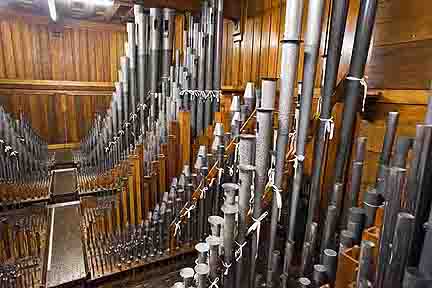
Ranks and Pipes
The Wanamaker Organ has 464 ranks of pipes, the most of any pipe organ. It possesses 28,750 pipes with nine expressive pipe divisions.
| PEDAL | 75 ranks, 81 stops, 2,573 pipes | |
| CHOIR | 24 ranks, 19 stops, 1,452 pipes | |
| GREAT | 58 ranks, 43 stops, 3,634 pipes | |
| SWELL | 71 ranks, 51 stops, 4,361 pipes | |
| SOLO | 51 ranks, 35 stops, 3,640 pipes | |
| ETHEREAL | 23 ranks, 21 stops, 1,670 pipes | |
| STRING | 88 ranks, 87 stops, 6,340 pipes | |
| STENTOR | 1 rank, 2 stops, 61 pipes | |
| ORCHESTRAL | 32 ranks, 32 stops, 2,312 pipes | |
| ECHO | 33 ranks, 22 stops, 2,013 pipes | |
| VOX CHORUS | 8 ranks, 8 stops, 572 pipes | |
| Click here for the STOPLIST. | ||
Wanamaker Organists
See a collection of Hymn Tunes written by Dr. Morgan HERE
Hear Mary Vogt perform for the radio HERE
Hear Keith Chapman perform HERE
Listen to a Peter Richard Conte concert HERE
About Peter Richard Conte

Mr. Conte is highly regarded as a skillful performer and arranger of organ transcriptions. He has been featured several times on National Public Radio and on ABC television’s Good Morning America and World News Tonight. His monthly radio show, The Wanamaker Organ Hour, aired for many years on WRTI-FM. In September 2008 he performed with the Philadelphia Orchestra in a Wanamaker Organ concert marking Macy’s 150th anniversary that won international acclaim. It featured the premiere of the Jongen Symphonie Concertante with the organ and orchestra for which it had been written in 1925.
He concertizes extensively throughout the United States and Canada under the management of Phillip Truckenbrod Concert Artists, and was a featured artist at the American Guild of Organists’ National Convention in 2002, and at the International Organ Festival in Aosta, Italy, in September 2004. He has performed with the Philadelphia Orchestra, Peter Nero and the Philly Pops, and with the Delaware and Allentown Symphonies. When not touring, he performs on the six-manual, 28,750-pipe Wanamaker instrument, which is played twice daily, six days each week.
In addition to his concert career, Mr. Conte serves as Choirmaster and Organist of St. Clement’s Episcopal Church, Philadelphia, where he directs an eighteen-voice professional choir in music of the Anglo-Catholic tradition. That choir has recorded several internationally-acclaimed compact discs on the Dorian label.
Peter Richard Conte is an Associate of the American Guild of Organists, and has served on the executive board of its Philadelphia Chapter. Mr. Conte studied with Larry Smith and Robert Rayfield at Indiana University, Bloomington, where he was awarded the prestigious Performers’ Certificate in Organ. He returned to Indiana University in 2008 to accept the School of Music’s Distinguished Alumni Award. During high school, he studied with Robert Kennedy, while serving as Associate Organist at the Cathedral of the Incarnation in Garden City, New York.
Mr. Conte appears on the Gothic, Raven, Dorian, JAV and DTR recording labels. His first Yuletide compact disc, Christmas in the Grand Tradition, features the Philadelphia Brass and the Wanamaker Organ. He is featured on several Friends of the Wanamaker Organ DVDs, including Sonic Odyssey, costarring Yale University organist Thomas Murray. Conte recordings are available at our Webstore or at the Macy’s Information Desk.
The Eagle
Like the Organ, the Eagle, also came from the St. Louis World’s Fair, where it was the centerpiece of the German Exhibit of Arts and Crafts Court of Honour. Made by the Armbruster Brothers in Frankfurt, Germany, purveyors to His Majesty the German Emperor, the Eagle is fashioned of “Durana” bronze. The wrought bronze was made by the Dueren Metal Works in Dueren,


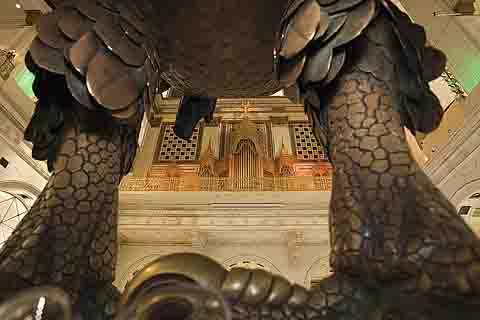
The sculpture measures 3 meters high, 2 meters long and is 1 meter across at the level of the breast with joined wings.
News clippings seemed to imply that the floor of the Grand Court had to be strengthened with girders to accommodate the sculpture, but because the flooring is now visible from the parking garage, it is believed that the eagle and its base were placed astride an existing girder. It is said the weight of the piece put a strain on the warehouse where it was stored while the Grand Court was being constructed. The composition is one meter wide, two meters long and three meters high.

Gaul, who specialized in animal sculptures, believed it was unnatural to sculpt an eagle in flight, and turned down a commission to supply eagles to a fountain in honor of the Kaiser near the Brandenburg Gate when he was not permitted to show his eagles in repose. The Armbruster Brothers had previously forged a heroic eagle for the 1900 Paris Exposition Universelle. It created a sensation and was something of an impetus for the creation of our eagle. The predecessor eagle, later purchased by Tiffany & Co., was sold to George Jay Gould, son of “robber baron” Jay Gould. George Gould died shortly after visiting the newly discovered tomb of King Tut, and his eagle 
A German press account spoke of the innovative forging techniques of the blacksmiths, the eagle’s warm, golden tone, the “half raised head, calm and sublime,” the whole sculpture releasing “a sense of it being a perfect conception of nature resting. It represents inviolable force and size with a feeling of superior vigilance.” Armbruster also fashioned an extremely elaborate set of gates for Chicago’s World’s Columbian Exposition (1893).



In 2020 David L. Wanamaker, who counts the Founder as a distant uncle, generously donated funds for EverGreene Architectural Arts to thoroughly clean the granite plinth on which the Eagle rests. This gift was given in honor of Mr. Wanamaker’s godson, Ashton Durham Taylor.
The Grand Court is something of Philadelphia’s “living room,” and here is an old Philadelphia custom to rendezvous in Center City by saying “Meet Me at the Eagle.”
The John Wanamaker
Memorial Founder’s Bell
The deep-voiced bell that rings from the belfry of the One South Broad building on South Broad Street and Penn Square in Philadelphia was commissioned by Rodman Wanamaker in 1926 as a memorial to his father, John Wanamaker, who died in 1922. Consequently, the bell is known as the Founder’s Bell. It was also cast to celebrate the Sesqui-Centennial of the United States of America and the 50th Anniversary of The New Kind of Store, John Wanamaker’s revolutionary department store.
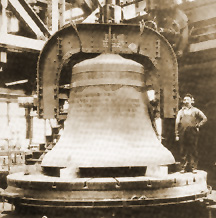
The Founder’s Bell was originally placed on the roof of the Wanamaker Philadelphia store, atop the North Tank House. Production delays caused its dedication to be postponed from the Fourth of July until New Year’s Eve 1926-27. Rodman Wanamaker himself pushed the button to ring the first note. However, the roof location proved inadequate, and in the 1930s the Wanamaker management provided a belfry where the bell could be fully swung. It was erected atop Wanamaker’s new men’s store, originally known as the Lincoln-Liberty building. The Founder’s Bell, whose majestic tone has been praised by Leopold Stokowski and many others, continues to ring the hours daily from its perch high above the city.
Many people, incidentally, mistakenly believe the sound comes from nearby City Hall. Although there is no official policy, the managers of the real-estate firm that manages the One South Broad building occasionally escort visitors to the belfry upon application for an appointment.
THE WANAMAKER GRAND ORGAN now at MACY’S has been thrilling Philadelphia shoppers and visitors every business day since 1911. Eighty years later, in the fall of 1991, an organization of the Friends Society was formed to support the preservation and musical mission of this irreplaceable American treasure.
Friends of the
Wanamaker Organ, Inc.

The official registration and financial information of the Friends of the Wanamaker Organ, Inc., may be obtained from the Pennsylvania Department of State by calling toll-free within Pennsylvania, 1-800-732-0999. Registration does not imply endorsement.
The Stentor is published in the Spring, Summer, Fall and Winter, with all renewals taking place at the beginning of the new year. The minimum annual donation is $25 per year special rate for new members. Those joining in the middle of the calendar year who do not wish to receive that year’s back issues can pay just for the issues still to be published (at $5 apiece). Kindly make checks payable to Friends of the Wanamaker Organ.
E-Mail the Friends
VIEW a spread of the newsletter
Please enclose your check with a brief note or print-out or facsimile of the Order Form and mail to the:
Friends of the Wanamaker Organ
630 Hidden Valley Road
King of Prussia, PA 19406-1712
With your support, we are making a difference!









